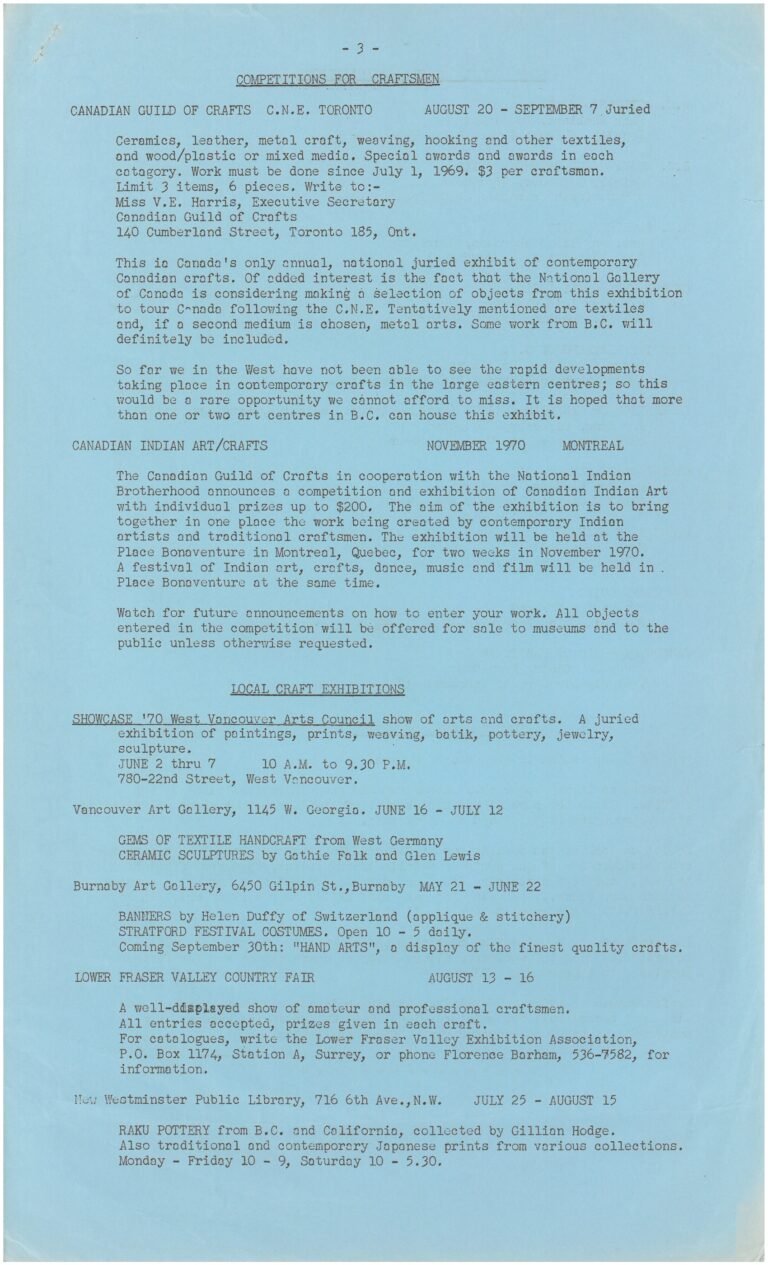CCBC’s biweekly blog “Craft Today”, which has predominantly covered contemporary craft practices and news related to, is taking a trip into the archive. We are traveling all the way back to the summer of 1970 to see what “craft today” looked like yesterday.
Prior to the establishment of the Craft Council of British Columbia, formally known as the Craftsmen’s Association of British Columbia, interested members of the Visual Arts Committee of the Community Arts Council of Vancouver were working tirelessly to develop a provincial craft association. The craft committee, headed by Margaret Lewis and made up of mostly women, started a newsletter with the intentions of providing information to and building a registry of crafts people within the province. The newsletter relied a great deal on public response and asked recipients to mail in names and addresses of established crafts people, guilds and schools. They asked readers to provide any information pertaining to craft courses and exhibitions happening in Vancouver and the surrounding area.

“Craft Contacts” was published every two months and was distributed “as far east as Ontario and as far south as California.” Subscription rates were kept low to encourage participants and to allow for greater accessibility. The newsletter was distributed to interested parties for nearly forty years with publication ceasing in 2009 as the council moved to digital formatting for sharing and distributing craft related content. Looking back on past “Craft Contacts” publications gives us a sense of the emerging and developing craft landscape in British Columbia and the first forty years of our beloved council. While these publications differ greatly from the visual art publications we see today, majority of which are digitally formatted, they remind us that healthy community relations and communication among crafts people play a huge role in what we do here at the council.




This week we are looking back at what was happening in BC craft during the summer of 1970:
A multitude of spaces including the James Cowen Centre (Burnaby), the Okanagan School of Arts and the University of British Columbia (Vancouver) were offering opportunities to learn the art of Batik. Batik is a cloth decorating technique that uses wax-resist dying. It requires the artist to select areas of cloth and block them out using hot wax. When the cloth is dyed, the waxed surfaces remain the original colour of the cloth. Batik is a technique originating in Java, Indonesia that has popularized in the West, as evidenced by the educational opportunities offered in BC at this time.
The World Craft Council held a meeting in Dublin, Ireland to discuss a topic that remains pertinent in craft today: “The Craftsman as Artist.” Haida artist Bob Davidson, known for carving, printmaking and painting, traveled to the host country to erect a ten-foot totem pole titled “Dublin Zoo” that he hand carved for the event.
In exhibitions history, the Vancouver Art Gallery, still in its original 1145 East Georgia location, held an exhibition featuring the sculptural work of local artists Gathie Falk and Glenn Lewis. Additionally, the Burnaby Art Gallery held an exhibition titled “Banners” which highlighted the applique and stitchery work of Swiss artist Helen Duffy.
To conclude the newsletter, Deidre Spencer, jeweler and weaver, shared with readers some thoughts she had on design. Deidre allowed that for the craftsperson to be artist, they “must plan and ever aspire to greater skill – never be satisfied with the mediocre, always ready to learn and search for further knowledge to improve [their] abilities.”
Deidre’s message to “Craft Contacts” readers in the summer of 1970, coupled with the theme of The World Craft Council meeting, shows us that the craftsperson vs artist debate was alive and well during this period. While this debate has yet to settle, with many still referring to craft as something outside of visual and fine arts, the exhibitions and educational opportunities focusing on craft practices highlighted in our early publication demonstrates the great influence of craft and craft persons within the arts.

